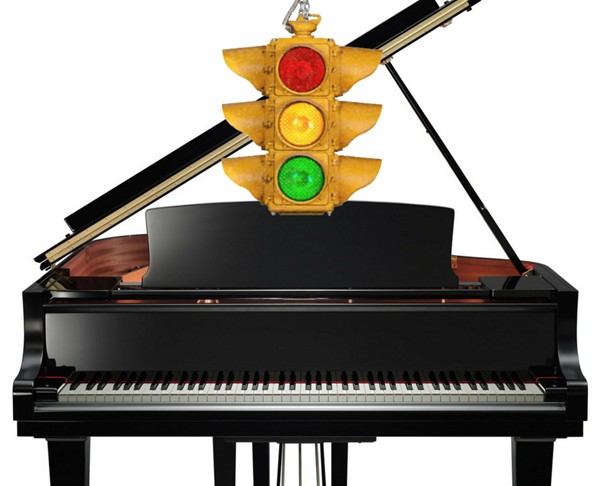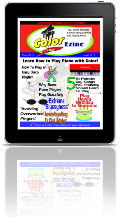A traffic light and a piano. Could these two objects be any more unrelated? It’s a strange title for an article but I promise to connect the dots as it relates to learning to play the piano as we progress through it. Most of us began to understand the concept of a traffic light at an early age. Ask any four year old and they’ll let quickly let you know how the stop and go system works.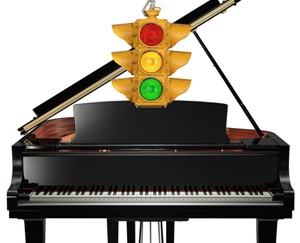
Just a few words about traffic lights…
The traffic light as we know it today has been around for about a hundred years. There have been changes in design and technology but the concept has not changed at all. Traffic lights are designed to regulate the flow of traffic and do it safely. But what is the psychology of the traffic light?
You have this object of transitioning colors. Depending upon the momentary color of the traffic light, you’re required to execute an immediate response. I’d also add that the response is a physical one. You might be required to quickly release your right foot from the accelerator pedal and press the brake left foot. You may be required to do the opposite of what I just described or the appropriate response may be to continue the action of acceleration, but with a warning that your required response is about to change. That is if you’re still within visual range of the traffic light.
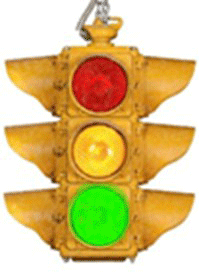 Think about it. All of these responses are a necessity at a moment’s notice. And I’ll emphasize, being conveyed to you merely by the shining of a colored light. This says a lot about color as a functional utility rather than a visual medium that simply displays an aesthetic to our sense of sight.
Think about it. All of these responses are a necessity at a moment’s notice. And I’ll emphasize, being conveyed to you merely by the shining of a colored light. This says a lot about color as a functional utility rather than a visual medium that simply displays an aesthetic to our sense of sight.
As I mentioned earlier, we learn the concept about a traffic light at an early age but we don’t put it into practice until we ourselves are behind the wheel as drivers. That’s when we really learn how to respond to the traffic light: by taking the physical action of operating the controls of a motor vehicle ourselves. So what can a traffic light teach you about learning to play the piano?
…more on traffic lights a little later.
Just a few words about piano lessons…
Let me ask you: Did you take piano lessons as a child? I myself did. I also took piano lessons as an adult. If you’re in either one of those categories, you probably know the one thing that all traditional piano lessons have in common. That one thing that I’m talking about is reading music. Written music can be very much like the traffic light that I explained earlier. Instead of traveling on a highway, you’re traveling across the page with all of those dots acting as signals provoking a required response from you to successfully get from beginning to end in a piece of music.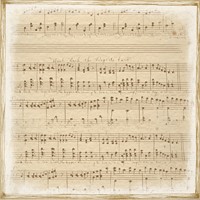
I don’t have to tell you that written music goes back a long way in history. It made sense because there was a time when the only way to record music was on paper. There was no audio recording technology and it was a necessity to record music in written form with absolute precision. That was the only way to preserve the composer’s creation. Think Beethoven and Bach. Oh, and did I mention that you would need a couple of well trained hands to perform it for you live?
Thankfully, we don’t live in an era where it’s a necessity to transcribe musical compositions on paper. This is especially true in the digital world that we live in now. We all have mini recording studios in our pocket that allow us to capture any musical idea and then instantly send it around the world if we wish to do so. And as you know, the recipient doesn’t need a couple of well trained hands to hear it either.
But there’s a rub with reading music and having to translate what’s written into actual sound. It’s literally what I just mentioned in my last sentence. You’re having to read signs and symbols. And you’re having to recreate those signs and symbols as sounds. Traditional piano instructors are teaching students how to play the instrument with the same methods that were being used a hundred years ago.
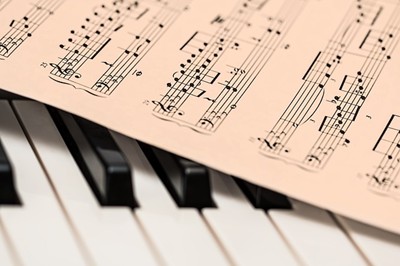 Please don’t misinterpret me by thinking that I’m opposed to traditional written music. I’m certainly not and I think there’s functionality to it. But I don’t think it should be the primary tool for piano instruction; Especially if the goal of the student is to play popular music as opposed to classical.
Please don’t misinterpret me by thinking that I’m opposed to traditional written music. I’m certainly not and I think there’s functionality to it. But I don’t think it should be the primary tool for piano instruction; Especially if the goal of the student is to play popular music as opposed to classical.
I won’t talk about more modern methods of music notation such as lead sheets and chord charts. But I mention them because they can be far more useful to contemporary piano and keyboard players today.
As far as learning how to play the piano with traditional written music, there’s the issue of complexity. Reading note values, rests, dynamics etc. are not complex to understand, but when you add the physical task of playing them on the keyboard in real time at tempo, it’s the very thing that causes so many piano students to quit before they reach an intermediate level.
If you look at the framework of just reading notes on the grand staff by itself, it’s easy to see what makes it difficult. You have notes that are arranged on lines and in spaces in different combinations. Relative positioning is what determines what the notes are.

Be aware that these notes can also be clustered together to signify chords.

Can you see how this gets complicated for traditional piano students?
What happens when you take any of these notes out of context like you see here?

Can you identify any of them?
Their relative positioning is gone, which means they’re unidentifiable. They’ve been moved. The point I’m making here is that the only way to distinguish different notes in traditional written music is where they’re located in this clustered environment of lines and spaces.
This is what makes learning how to play the piano difficult and seem as though it’s too much work and not enough reward. But you do need some type of notational system to learn, but I’ll get to that later.
For now, let’s get back to the traffic light that I discussed earlier.
Let’s pretend that we lived in a world without the traffic light as we know it. Sure, it would have three different lights, but it would have one distinguishable difference: None of the lights would be in color. It sounds ridiculous, I know. But let’s just pretend.
So instead of: Red Light-Stop, Yellow Light-Slow, Green Light-Go.
It would be: Top Light-Stop, Middle Light-Slow, Bottom Light-Go. No color, just the relative 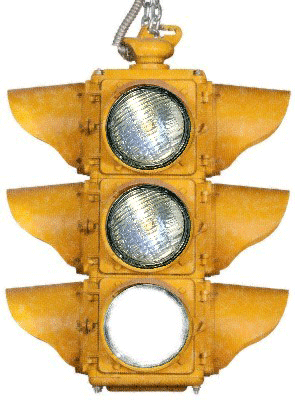 position of one light to the other two lights. Do you think that maybe you would have to concentrate a little or maybe a lot harder on the light to determine what action to take? I would say that such a system of regulating traffic would be ineffective and dangerous.
position of one light to the other two lights. Do you think that maybe you would have to concentrate a little or maybe a lot harder on the light to determine what action to take? I would say that such a system of regulating traffic would be ineffective and dangerous.
It’s obvious that the relative positioning of traffic lights are nowhere near as effective as incorporating the use of color within them. Color is instantly recognizable. The bottom line is that color conveys information without having to read. A traffic light reinforces this concept due to the fact the colors are consistently changing, yet it’s not a struggle for us drivers to get the information from them instantly.
By now, you don’t have to be super intuitive to see what a traffic light can teach you about learning to play the piano. Color, if utilized properly, can be the deciding factor whether you start learning and stay engaged or whether you get bored and drop out. I’ll cover how this color thing works in a moment.
So why do you need any kind of notational system at all? I hear a lot of talk about playing by ear. If that’s possible, why would you need any kind of written music?
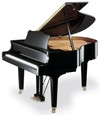 Without getting into a lot of detail about learning to play the piano by ear, it would be putting the cart before the horse if you weren’t familiar with chords, keys of music, chord patterns, etc. Playing the piano by ear is a learned skill after certain other skills are in place to enable you to do so. But don’t be intimidated or taken back by the prospect of learning those skills. Not only are they simple to understand, they’re actually fun and exciting to learn if approached in the right way.
Without getting into a lot of detail about learning to play the piano by ear, it would be putting the cart before the horse if you weren’t familiar with chords, keys of music, chord patterns, etc. Playing the piano by ear is a learned skill after certain other skills are in place to enable you to do so. But don’t be intimidated or taken back by the prospect of learning those skills. Not only are they simple to understand, they’re actually fun and exciting to learn if approached in the right way.
The right way to approach those skills is to do it visually. That’s the correct way to approach almost any skill! How many times have you said, “Can you show me how to do that?” or “I need to see how it’s done?” But you may already know that traditional written music isn’t the only way to notate music.
The most common written music outside of the traditional form is writing the notes in letter form themselves.
![]()
You’ve probably also seen chords notated this way in large clusters of letters.
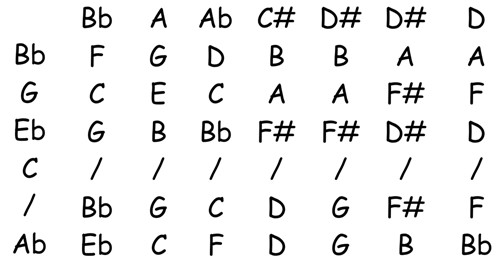
The problem with this type of hand written notation is that you’re still required to read and the more notes you have, the greater the task is to process all of this information. In addition to this, you’re focused on notes when you should be focused on numbers.
So what do numbers have to do with music? I’m glad you asked. (No, I haven’t forgotten about how the color thing works)
What I’m actually referring to is the number system. When your goal is to play popular music, the number system is everything. When I say popular music, I’m referring to every style of music that is not classical. Pop, jazz, rock, blues, country, new age, salsa, etc. are all examples of popular music.
The number system consists of numbering the tones in a key of music to make it easier and simpler![]() to create chords, chord patterns and chord progressions. This allows you to follow a formula for learning, composing and performing songs and musical concepts in all possible keys. Let me emphasize that no chord playing musician can ever be effective until they learn the number system. Let me say it again: The Number System Is Everything.
to create chords, chord patterns and chord progressions. This allows you to follow a formula for learning, composing and performing songs and musical concepts in all possible keys. Let me emphasize that no chord playing musician can ever be effective until they learn the number system. Let me say it again: The Number System Is Everything.
So why do you need to have any notational system to learn piano at all? There are two things that’s necessary from any type of music notation in order for it to be effective. It needs to be stationary and illustrative. A stationary notational system allows you to play music at any pace you’re moving. Video is a great supplement, but it’s moving too fast for you to follow along with in real time. The illustrative aspect allows your mind to stay interested and engaged.
Here’s where color comes in. We’ve learned that color can convey information effectively with the example of a traffic light. So the solution is to utilize color as a medium to teach the mechanics of music in a fun and interesting way.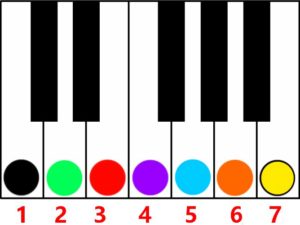
This is where I’m going to introduce you to Color Score. It’s a visual method of learning how to play the piano visually so you can sound like a professional without years of traditional piano study.
Color Score uses the same principal of a traffic light. It incorporates color in a very illustrated music notational system of learning chords, voicings, rhythms and ultimately songs so you can sound like a professional at your piano or keyboard.
In a Major key of music you have seven different notes in a numbered sequence. Each one of those numbers are represented by a series of seven different colors which occur in the same order no matter what key you’re in.
There are two formats in Color Score: Keyshots and Noteshots.

The first tool of Color Score is called a Keyshot. It’s a very familiar graphic that you may recognize as a simple keyboard but it contains some very special information for the purpose of displaying a chord visually.
A Keyshot very plainly shows each note in a chord voicing. There’s a chord symbol that’s color coded in respect to the key it’s in and the colors themselves do not represent individual notes. Instead, they represent the structure of the key the chord is in. That is, the number system. Each note in a key of music has a numerical sequence. This is the structure that every chord in existence has ever been created from.

A Keyshot is a visual representation of a chord. This is a simple but very powerful learning tool. You can be at a very beginner level and play some very advanced chords and progressions. But you’re not just playing clusters of notes without an understanding of what they are. You’re learning how these and any possible chords are constructed.
A Noteshot is just as colorful as a Keyshot and represents the structure of chords exactly the same. But they can do something that Noteshots can’t do: show rhythm. They can also show a particular chord voicing in all 12 keys. Noteshots were created to teach you how to play rhythms the simplest way possible.
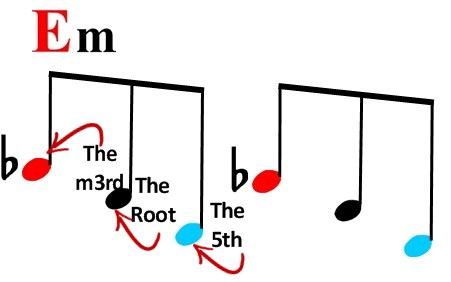
What is the bottom line to learn how to play the piano in a colorful illustrative way, instead of traditional note reading and exercises that have been around forever?
It keeps you engaged. It’s interesting. It’s fun. What’s even more, it’s exciting. When you start hearing chords, voicings and songs coming from your own piano or keyboard, you realize the freedom that you have to create your own musical journey every day. You’ll also wonder why learning how to play the piano ever had to be so difficult in the first place.
Believe it or not, that’s what a traffic light can teach you about learning to play the piano.
Find out more about Color Score.
Until next time, Go Play.
Greg Lee
Latest posts by Greg Lee (see all)
- What is a minor/Major 7 Chord? - October 26, 2023
- 7 Chord Substitutions that Professionals Use - October 19, 2023
- 5 Simple Chord Tricks to Sound Amazing - October 5, 2023

